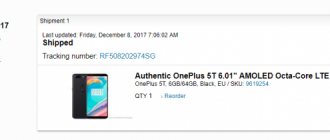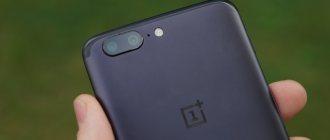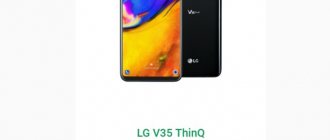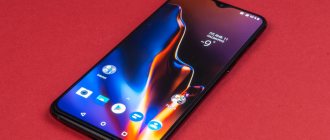OnePlus is a unique company of its kind, which releases smartphones only twice a year and always takes into account user opinions when developing them. But the new OnePlus 6T shows that this will not always be the case. The manufacturer decided to go his own way and do it the way he wanted, which definitely won’t please everyone. Last year, the head of the company said that 80% of users continue to use the classic 3.5 mm headphone jack, while OnePlus 6T was deprived of this port, so all that remains is to either use an adapter or a wireless headset. They also talked about an LED event indicator, which made working with the phone more comfortable, but the new product did not have it.
If we close our eyes to the shortcomings described above, then we are offered the fastest smartphone at the end of 2020, which has good battery life, a bright design with a teardrop notch and a user-friendly interface that is as similar as possible to pure Android. Let's take a full review of the OnePlus 6T and take you through all the pros and cons of the new model.
Differences between OnePlus 6T and OnePlus 6
- The display diagonal has been increased to 6.4 inches;
- The case has become thicker, which is due to an increase in battery capacity to 3700 mAh;
- The 3.5 mm jack and LED event indicator are missing.
These are the main changes, and we will talk in more detail as part of our review.
⇡#Autonomous work
OnePlus 6 can generally be called an example of tight-fisted engineering. Despite the apparent dissimilarity from its predecessors at first glance, this smartphone repeats them in many details: why order new components if the old ones still serve well? On the one hand, the display has grown by 0.3 inches, on the other, OnePlus 6 uses a more energy-efficient platform. Therefore, the developers thought, the battery does not need to be changed. The battery here is the same as in the OnePlus 5T and even in the OnePlus 5 - with a capacity of 12.54 Wh (3300 mAh, 3.8 V).
Well, the calculation turned out to be correct - autonomy has deteriorated, but not so significantly as to turn into a glaring drawback of the smartphone. OnePlus 6 no longer claims to work for a day, but it can easily withstand daylight hours, even under the most serious load.
In our traditional test with HD video playback at maximum brightness, with Wi-Fi and notifications turned on, the smartphone was inferior to its predecessor, but due to the AMOLED display it still provides excellent numbers - almost 14 hours of operation without recharging.
The OnePlus 6 is charged using the USB Type-C port - unfortunately, it is still a USB 2.0 standard with a low data transfer speed. The kit includes a Dash Charge adapter that uses a voltage of 5 V and a current of 4 A. It allows you to replenish half the charge in 25 minutes, and fully charges in an hour and a half.
Design and photos of the OnePlus 6T smartphone
Externally, the hero of our review is practically indistinguishable from OnePlus 6 - the material used for the case is still glass in combination with metal side frames, which gives the structure the necessary level of rigidity. There are only two color options - Mirror Black and Midnight Black. In the first case, the backdrop will be glossy, and in the second it will be matte. For those who want something special, there is a McLaren Edition in Speed Orange. It has a carbon fiber pattern and looks especially beautiful, but the price will be much higher, so few will be able to afford such a pleasure.
The version with a glossy case is quite slippery and quickly becomes covered with fingerprints, so a protective case is strictly recommended. Without it, there is a high probability of dropping the phone from your hands.
The top edge is occupied by a noise-canceling microphone and an earpiece.
On the right is a distinctive feature of the brand's smartphones - a rocker for switching notification modes and a power key.
On the left is a tray for SIM cards and a volume rocker.
At the bottom there is a USB Type-C port and an external speaker hole. Alas, the 3.5 mm jack was abandoned in the new product. The solution would be to use a wireless headset, a complete adapter for classic headphones, or a proprietary headset for a USB Type-C connector, which can be found on Aliexpress for around $20.
At the back, the design almost completely copies the OnePlus 6 - a dual main camera in the middle and a flash attached to it. But there is still one difference - the fingerprint scanner, which is now built into the screen, has disappeared.
The screen has become larger, which becomes noticeable even when you turn it on for the first time. The main thing that many fans will like is that they got rid of the huge cutout at the top. It has become teardrop-shaped, so it is practically invisible and leaves more usable display area. The speaker grid has moved higher. It can be seen between the screen and the top edge of the OnePlus 6T phone. True, to implement this solution we had to abandon the LED event indicator, for which there was simply no place. The case is assembled with high quality and feels pleasant in the hand. But it is quite large, so it will be uncomfortable for you to type text while holding it with one hand.
⇡#Appearance, ergonomics and software
OnePlus devices have never been examples of originality in terms of design, but even against this background, OnePlus 6 seems somehow too ordinary. Its very well-cut body bears all the features of the times: from that very “unibrow” in the area of the status bar to the back panel, made of polished, almost mirror glass, in the middle of which a double camera has grown, noticeably protruding above the body. OnePlus cannot be accused of imitating anyone - it is similar to all modern smartphones at once. For a gadget that claims to replace everyone at once, this can probably even be considered a good feature.
However, there is OnePlus 6 not only in a fashionable mirror version - a matte version of the same black color (Midnight Black) is also available, and in early June a matte white OnePlus 6 (Silk White) appeared. Plus, just recently, on July 10, a red “six” went on sale, which is just as shimmering as the black Mirror Black that we tested.
OnePlus 6 in case
You can’t find fault with the quality of the device – it’s a full-fledged top-level device. Metal edges, slightly curved back, making the gadget comfortable to hold in your hand, very good weight balancing. If it were not for the inevitable soiling of the mirror body and the inability to use a smartphone with a 6.28-inch display with one hand, then everything would have been fine.
OnePlus 6, front panel: in the cutout – earpiece, front camera, status indicator and light sensor; on the screen - protective film
The smartphone comes with a silicone case, which is almost mandatory for use with a glossy device. It, of course, makes the appearance less impressive and increases the thickness of the case, but it allows you to avoid wiping it every day.
OnePlus 6, rear panel: dual camera unit protruding above the body and dual LED flash; underneath is a fingerprint scanner
“If you copy something, do it brazenly and with a serious face” - OnePlus follows this law with great diligence. The cutout at the top of the screen dooms the smartphone to comparison with the iPhone X, but company executives commented on this design move even before the release of the “six”, at the same time declaring that their cutout is better, simply because it takes up less space. Yes, indeed, it is very small and comparable in size to what we saw on the Huawei P20/P20 Pro. It contains a speaker, a status indicator and a front camera.
OnePlus 6, left side: volume key/camera shutter release and slot for two nano-SIM
OnePlus 6, right side: power key and sound profile switch
The remaining functional elements are familiar from previous OnePlus smartphones: the power and volume keys located on opposite sides of the body, and the sound mode switch, made in the form of a slider.
OnePlus 6, top edge: additional microphone
OnePlus 6, bottom edge: main speaker, USB Type-C port, conversational microphone and mini-jack for headset/headphones
On the bottom edge you can find an analog jack for headphones/headsets, but, unfortunately, the Chinese did not follow in the footsteps of LG or Samsung - there is a jack, but OnePlus 6 does not have any declared security standard. Another thing is that OnePlus itself states that the smartphone will withstand some contact with water, and you shouldn’t panic if you dip your gadget in a puddle. And when disassembling the smartphone, various specialists, including those from iFixit, found the necessary gaskets and plugs, which indicate an approximate level of moisture protection IP67. But OnePlus is not going to bear warranty obligations, so we cannot speak confidently about the IP67 standard, and especially IP68.
On the back panel, two camera lenses are lined up in a vertical row, along with a dual LED flash and a fingerprint scanner. While it’s the off-season, the entire front panel is usually occupied by a 19:9 format display, and there are no high-quality ultrasound scanners that can fit under the screen on the market. This transition period has advantages: you can enjoy the scanner located in the most convenient place - where your finger falls automatically, without grabbing the smartphone in your hand.
Along with a scanner (using a classic capacitive sensor), you can unlock your smartphone using your own face. As before, OnePlus uses the front camera for this. Only, unlike most smartphones on Android 8.0 Oreo, which have learned the same trick en masse, the “six” copes with this task remarkably well - even if it does not provide sufficient protection against unlocking, for example, using a photograph, it recognizes a face instantly and almost accurately. And it even works in almost complete darkness, using the natural light of the screen to illuminate the face.
Oxygen 5.1 shell
View all images (23)
OnePlus 6 runs on Android 8.1.0 Oreo with the Oxygen shell, version 5.1.8 current at the time of writing this review. The shell, frankly speaking, is barely noticeable - it minimally changes the appearance of pure Android, adding to it the proprietary service Never Settle, which replaces Google Now, which allows you to supplement the displayed information with both the dies provided by the developers and any widgets at your discretion. Of the pre-installed software, it is worth noting only the rewritten basic applications and the client for the One Community forum platform. The shell is very light, fast and unobtrusive - one of the best today.
How well does the in-screen fingerprint scanner work?
Starting with OnePlus 5T, the fingerprint scanner is mounted on the back, which allows for a smaller bottom bezel at the front. But from the point of view of users, this is not the most convenient solution, since it is more difficult to find blindly. To solve this problem, it was decided to integrate it into the screen in the new product. The scanner's coverage area is marked with a pattern to which you need to place your finger and after a moment the smartphone screen will be unlocked. This is not the first phone to use this technology, but in OnePlus it is definitely the fastest and is almost as good as a traditional fingerprint scanner.
There's an optical sensor underneath the One Plus 6T's screen, so in theory it should only work well in good lighting conditions. But in fact, it works well even in complete darkness due to the fact that the desired part of the display is illuminated. The only problem that is relevant for all phones with an in-screen scanner is that if your hands are very cold in the cold, the unlocking process takes longer or does not happen at all.
⇡#Camera
OnePlus 5 and 5T used the same rear camera design - with two modules and a hybrid zoom: the 20-megapixel module differs from the main, 16-megapixel, in focal length by only 1.5 times, and a twofold zoom could only be achieved with additional crop. This approach inevitably leads to a decrease in the quality of shooting - and, it would seem, in its new numbered flagship, OnePlus should have used a full-fledged, rather than half-hearted, solution.
Alas, everything remains as it was, and moreover, absolutely the same modules are used: Sony IMX 519 + lens with an aperture of ƒ/1.7 and Sony IMX376K with a lens with the same aperture. It’s interesting that, according to the manufacturer, the main wide-angle camera uses a contrast autofocus scheme, and the “portrait” one uses a phase autofocus scheme. The scheme, like last time, does not always work stably, regardless of the lighting - you can get a blurry shot even in ideal conditions, so it’s always worth doing a couple of takes.
| On the left - examples of shooting with a wide-angle camera, on the right - with a 2x zoom | ||
But you shouldn’t immediately give OnePlus a “bad” rating for its work on the camera, which is already inferior to most of its competitors – the “six” introduced optical image stabilization for the first time, which significantly improves the camera’s capabilities when shooting in the dark. Software processing is still not the strong point of a smartphone, but getting a blur-free frame with normal detail has now become much easier. True, with one caveat: no zoom, since the additional stabilization camera, as is usually the case, is deprived.
| OnePlus 6 camera app interface | ||
The interface and capabilities of the camera remained unchanged: switching between operating modes by swiping the screen, portrait mode with software background blur, manual mode with a virtual horizon (using the built-in gyroscope), interval and slow-motion shooting.
Example of a portrait with software background blur
Overall, the picture quality is quite decent, but not outstanding - here the OnePlus 6 is inferior not only to more expensive smartphones like the Huawei P20 Pro, Samsung Galaxy S9, iPhone X or LG G7 ThinQ, but even to the Honor 10, which lacks optical stabilization. The advantages of the OnePlus 6 camera are good colors and the ability to shoot in RAW (DNG) format. Disadvantages – shooting quality in “portrait” mode, weak dynamic range, lack of detail.
Gallery
View all images (23)Video recording is carried out with a maximum resolution of 4K at a frequency of up to 60 frames per second. Electronic stabilization available.
Example of a self-portrait with software background blur
The front camera migrated to the OnePlus 6 from the 5T model without changes: a relatively large sensor (1/3.0'') with high resolution (16 megapixels), a good lens with an ƒ/2.0 aperture. It allows you to take good selfies not only outdoors during the day, but also indoors - even without a flash (which is not present here). Spatial distortion is moderate, there is software background blur. But OnePlus developers decided to do without augmented reality masks that seemed mandatory. However, no one is stopping you from using any of the many third-party services presented.
Screen with a waterdrop notch at the top
The display is one of the main changes in the OnePlus 6T. It has become better and most importantly, they got rid of the huge cutout at the top, which obscured some of the content and did not accommodate all the notifications. The diagonal of the AMOLED screen has been increased from 6.28 to 6.41 inches. True, the dimensions were obtained without taking into account the rounded edges. With them the diagonal will be smaller - 6.24 inches. The resolution has also increased. It is now 2340x1080, which gives 402 pixels per inch. With such characteristics, there are no problems with detailing, the picture looks great.
The main change that catches your eye is the miniature teardrop-shaped cutout on top, which houses the front camera. This approach turned out to be more practical and convenient than the notch, which was borrowed from Apple throughout the year. The display surface is covered with tempered Gorilla Glass 6 with high-quality oleophobic coating. You shouldn't drop your smartphone or carry it in the same pocket as your keys, but the level of protection has certainly improved.
OnePlus 6T has several color profiles. sRGB produces more saturated colors, while DCI-P3 produces calmer colors. It is better to switch the standard mode to adaptive or DCI-P3, otherwise the colors will turn out too saturated and unrealistic. In addition, this puts increased strain on the eyes, quickly tiring them when working with the phone. When reading mode is active, the screen turns black and white. In the settings, you can set it to turn on automatically when you launch certain programs, for example, FBReader. Viewing angles and brightness levels are at the highest level, as befits a flagship. The screen occupies 87% of the front panel.
⇡#Display and sound
OnePlus 6 has a display very close in characteristics to what we saw in OnePlus 5T - the diagonal has grown slightly and the format has changed (6.28 versus 6 inches, 19:9 versus 18:9), but the resolution has not changed fundamentally – the same “stretched” Full HD, here – 2280 × 1080 pixels. The pixel density is 402 ppi. This is not much, but in ordinary conditions (without a magnifying glass or virtual reality glasses) it is impossible to discern pixelation.
OnePlus 6 has a protective film on its screen
Viewing angles are free - even with extreme deviation of the view from the perpendicular, contrast is not lost and colors are not distorted.
The brightness is 431 cd/m2 - very good for an organic LED screen. There is no air gap, there is a polarization layer - you can use the smartphone in any light, including under direct sunlight. In this case, you don’t need to pay too much attention to the brightness number - compared to LCD displays, OLED has a clear advantage here.
For the OnePlus 6 display, you can choose several setting options in the “screen calibration” section: either let the smartphone determine the color rendition itself, or adjust the color temperature yourself, or simply select a color space. I tested the 6's screen in default mode and with sRGB space.
There is also the usual night mode with a blue color filter, but it is also offered separately, in which the smartphone either always or only when running selected applications will change the color rendition for the most comfortable reading depending on the external lighting - up to the introduction of a black and white gamma. It’s really nice to read in this mode, but this mode was created precisely for this purpose, and not to save energy.
OnePlus 6, gamma in default display calibration mode. Yellow line – OnePlus 6 indicators, dotted line – reference gamma
OnePlus 6, color temperature in default display calibration mode. Blue line – OnePlus 6 indicators, dotted line – reference temperature
OnePlus 6, color gamut in default display calibration mode. Gray triangle – sRGB coverage, white triangle – OnePlus 6 coverage
In the default color rendering mode, the gamma is 2.27 with a slight spread of indicators in light colors. Temperatures average around 7,700 K, with colors a little colder than they should be. The average deviation for the extended Color Checker palette (shades of gray + a wide range of color shades) is 5.73 - quite far from the norm, the upper limit of which is 3.00, but better than many. The color gamut is much wider than the sRGB standard, closer to DCI-P3. Even without changing the color rendering in the settings, you can use your smartphone comfortably – if, of course, you like cool shades.
OnePlus 6, gamma in display calibration mode for the sRGB color gamut. Yellow line – OnePlus 6 indicators, dotted line – reference gamma
OnePlus 6, color temperature in sRGB calibration mode. Blue line – OnePlus 6 indicators, dotted line – reference temperature
OnePlus 6, color gamut in display calibration mode based on the sRGB color gamut. Gray triangle – sRGB coverage, white triangle – OnePlus 6 coverage
When calibrated to the sRGB color space in the settings, we get warmer and more natural color reproduction. Gamma is 2.31, color temperature is kept at the reference level of 6,500 K, and the average Delta E value according to the Color Checker table is within the normal range - 2.76.
The mini-jack in OnePlus 6 immediately puts you in a good mood - at least you don’t need to use “crutches” and definitely look for high-quality wireless headphones. But in general, in terms of its sound, the “six”, like its predecessors, is nothing special. There is enough volume, there is bass, there is no bright accent at some frequencies, and there is no loss of individual spectra - this is enough for most users. The main speaker is exactly the same - not loud enough and with very mediocre sound quality. This is especially noticeable against the background of the recently tested HTC U12+. It’s comfortable to talk using OnePlus 6.
OnePlus 6T performance and specifications
The technical characteristics of the smartphone are based on the flagship processor of 2020 - Qualcomm Snapdragon 845. It has 8 cores with a frequency of up to 2.8 GHz. This is a powerful chip made using a 10-nm process technology, which, in combination with the Adreno 630 graphics accelerator, gives a good performance reserve for the future. The interface simply flies, and there are no problems with multitasking thanks to 6 or 8 GB of RAM. Even 6 GB is enough for normal operation of the phone, so in our opinion it is not worth overpaying for the older modification. Flash memory can be 128 or 256 GB UFS 2.1 type.
Test in Antutu and Geekbench
At peak loads, the OnePlus 6T did not heat up above 47 degrees. The heat is evenly distributed throughout the body, so it has virtually no impact on performance or comfort. The manufacturer has managed to squeeze the maximum out of the processor's capabilities, so you can be sure that its power will last for at least several more years. It easily runs modern games at maximum graphics, while the number of frames remains stable around 60. There is an NFC chip, Bluetooth 5.0, support for aptX HD codecs, Wi-Fi 2.4 and 5 GHz. The device runs on the Android 9 operating system, on top of which is a convenient and functional proprietary OxygenOS shell.
⇡#Technical characteristics
| OnePlus 6T | OnePlus 6 | Xiaomi Mi 8 | Huawei P20 Pro | Oppo RX17 Pro | |
| Display | 6.41 inches, AMOLED, 2340 × 1080 pixels, 402 ppi, capacitive multi-touch | 6.28 inches, AMOLED, 2280 × 1080 pixels, 402 ppi, capacitive multi-touch | 6.21 inches, AMOLED, 2246 × 1080 pixels, 402 ppi, capacitive multi-touch | 6.1 inches, OLED, 2240 × 1080 pixels, 408 ppi, capacitive multi-touch | 6.4 inches, AMOLED, 2340 × 1080 pixels, 401 ppi, capacitive multi-touch |
| Protective glass | Corning Gorilla Glass 6 | Corning Gorilla Glass 5 | Corning Gorilla Glass 5 | No information | Corning Gorilla Glass 6 |
| CPU | Qualcomm Snapdragon 845: four Kryo 385 Gold cores, 2.8 GHz + four Kryo 385 Silver cores, 1.7 GHz | Qualcomm Snapdragon 845: four Kryo 385 Gold cores, 2.8 GHz + four Kryo 385 Silver cores, 1.7 GHz | Qualcomm Snapdragon 845: four Kryo 385 Gold cores, 2.8 GHz + four Kryo 385 Silver cores, 1.7 GHz | HiSilicon Kirin 970: four ARM Cortex A73 cores, 2.4 GHz + four ARM Cortex A53 cores, 1.8 GHz; HiAI architecture | Qualcomm Snapdragon 710: two Kryo 360 Gold cores, 2.2 GHz + six Kryo 360 Silver cores, 1.7 GHz |
| Graphics controller | Adreno 630, 710 MHz | Adreno 630, 710 MHz | Adreno 630, 710 MHz | ARM Mali-G72 MP12, 850 MHz | Adreno 616, 750 MHz |
| RAM | 6/8/10 GB | 6/8 GB | 6 GB | 6 GB | 6 GB |
| Flash memory | 128/256 GB | 64/128/256 GB | 64/128/256 GB | 128 GB | 128 GB |
| Memory card support | No | No | No | No | Eat |
| Connectors | USB Type-C | USB Type-C, 3.5 mm minijack | USB Type-C | USB Type-C | USB Type-C |
| SIM cards | Two nano-SIMs | Two nano-SIMs | Two nano-SIMs | Two nano-SIMs | Two nano-SIMs |
| Cellular connection 2G | GSM 850/900/1800/1900 MHz CDMA 800/1900 | GSM 850/900/1800/1900 MHz CDMA 800/1900 | GSM 850/900/1800/1900 MHz | GSM 850 / 900 / 1800 / 1900 MHz | GSM 850/900/1800/1900 MHz |
| Cellular 3G | HSDPA 800 / 850 / 900 / 1700 / 1800 / 1900 / 2100 MHz | HSDPA 800 / 850 / 900 / 1700 / 1900 / 2100 MHz | UMTS 850 / 900 / 1900 / 2100 | HSDPA 850 / 900 / 1700 / 1900 / 2100 MHz | WCDMA 800 / 850 / 900 / 1700 / 1900 / 2100 MHz |
| Cellular 4G | LTE Cat.16 (up to 1024 Mbps): bands 1, 2, 3, 4, 5, 7, 8, 12, 13, 17, 18, 19, 20, 25, 26, 28, 29, 30, 32 , 34, 38, 39, 40, 41, 46, 66, 71 | LTE Cat.16 (up to 1024 Mbps): bands 1, 2, 3, 4, 5, 7, 8, 12, 17, 18, 19, 20, 25, 26, 28, 29, 30, 32, 34 , 38, 39, 40, 41, 66, 70 | LTE Cat. 16 (up to 1024 Mbit/s): bands 1, 3, 4, 5, 7, 8, 20, 34, 38, 39, 40, 41 | LTE Cat. 18 (up to 1200 Mbit/s), bands 1, 2, 3, 4, 5, 6, 7, 8, 9, 12, 17, 18, 19, 20, 26, 28, 32, 34, 38, 39, 40, 41 | LTE Cat.15 (up to 800 Mbps): bands 1, 2, 3, 4, 5, 7, 8, 12, 17, 18, 19, 20, 25, 26, 28, 32, 34, 38, 39 , 40, 41 |
| WiFi | 802.11a/b/g/n/ac | 802.11a/b/g/n/ac | 802.11a/b/g/n/ac | 802.11a/b/g/n/ac | 802.11a/b/g/n/ac |
| Bluetooth | 5.0 | 5.0 | 5.0 | 4.2 (aptX HD) | 5.0 |
| NFC | Eat | Eat | Eat | Eat | Eat |
| Navigation | GPS, A-GPS, GLONASS, BeiDou, Galileo | GPS, A-GPS, GLONASS, BeiDou, Galileo | GPS, A-GPS, GLONASS, BeiDou | GPS, A-GPS, GLONASS, BeiDou | GPS, A-GPS, GLONASS, BeiDou, Galileo |
| Sensors | Illumination, proximity, accelerometer/gyroscope, magnetometer (digital compass) | Illumination, proximity, accelerometer/gyroscope, magnetometer (digital compass) | Illumination, proximity, accelerometer/gyroscope, magnetometer (digital compass) | Light, proximity, accelerometer/gyroscope, magnetometer (digital compass), IR sensor | Illumination, proximity, accelerometer/gyroscope, magnetometer (digital compass) |
| Fingerprint's scanner | Yes, on the screen | Eat | Eat | Eat | Yes, on the screen |
| Main camera | Dual module, 16 + 20 MP, ƒ/1.7 + ƒ/1.7, hybrid autofocus, dual LED flash | Dual module, 16 + 20 MP, ƒ/1.7 + ƒ/1.7, hybrid autofocus, dual LED flash | Dual module: 12 MP, ƒ/1.8 + 12 MP, ƒ/2.4, phase detection autofocus, optical stabilization (with main camera) | Triple module, 40 + 20 + 8 MP, ƒ/1.8 + ƒ/1.6 + ƒ/2.4, hybrid autofocus, optical stabilization, dual LED flash | Dual module, 12 + 20 MP, ƒ/1.5-2.4 + ƒ/2.6, phase detection autofocus, optical stabilization, LED flash |
| Front-camera | 16 MP, ƒ/2.0, fixed focus | 16 MP, ƒ/2.0, fixed focus | 20 MP, ƒ/2.0, fixed focus | 24 MP, ƒ/2.0, fixed focus, no flash | 25 MP, ƒ/2.0, fixed focus, no flash |
| Nutrition | Non-removable battery: 14.06 Wh (3700 mAh, 3.8 V) | Non-removable battery: 12.54 Wh (3300 mAh, 3.8 V) | Non-removable battery: 12.92 Wh (3400 mAh, 3.8 V) | Non-removable battery: 15.2 Wh (4000 mAh, 3.8 V) | Non-removable battery: 14.06 Wh (3700 mAh, 3.8 V) |
| Size | 157.5 × 74.8 × 8.2 mm | 155.7 × 75.4 × 7.75 mm | 154.9 × 74.8 × 7.6 mm | 155 × 73.9 × 7.8 mm | 157.6 × 74.6 × 7.9 mm |
| Weight | 185 grams | 177 grams | 175 grams | 180 grams | 183 grams |
| Housing protection | No | No | No | IP67 | No |
| operating system | Android 9.0 Pie, OxygenOS shell | Android 8.1 Oreo, OxygenOS shell | Android 8.1.0 Oreo, MIUI shell | Android 8.0 Oreo, EMUI shell | Android 8.1 Oreo, ColorOS shell |
| Current price | 35,260 rubles for the 6/128 GB version, 37,800 rubles for the 8/128 GB version, 45,250 rubles for the 8/256 GB version | 36,500 rubles for the 6/64 GB version, 32,900 rubles for the 8/128 GB version, 47,000 rubles for the 8/256 GB version | 27,490 rubles for the 6/64 GB version, 28,990 rubles for the 6/128 GB version, 28,150 rubles for the 6/256 GB version | 46,700 rubles | 49,990 rubles |
| OnePlus 6T – information about the filling according to the CPU-Z application | ||||
Battery life has become even longer
A review of the OnePlus 6T smartphone showed positive changes. If the predecessor had a 3300 mAh battery, then in the 6T the battery capacity was increased to 3700 mAh. True, along with this, the diagonal of the display has also grown, which means that battery life has remained at the same level. The battery test showed the following results:
- About 6 hours of Internet surfing;
- 6.5 hours of video playback;
- 3.5 hours of operation at maximum loads.
Fast charging technology is supported, thanks to which after 30 minutes the smartphone is charged to 50%, and in an hour to 89%. A fully charged battery lasts for a day of active use.
⇡#Communications and wireless communications
OnePlus 6 has a standard design for today with two nano-SIMs and one radio module. Moreover, both support operation with LTE with a theoretically possible data reception speed of up to 1024 Mbit/s, and transmission speed of 150 Mbit/s (Cat.16/Cat.13). There will be no problems with coverage, regardless of whether you buy a “gray” or “white” OnePlus - the device has one version, international, and it supports work with a large number of bands (one more than OnePlus 5). Including all those that are used in Russia.
OnePlus 6, slot for two nano-SIM cards
The set of wireless modules for a smartphone of this level is standard: Bluetooth 5.0 (with support for aptX and aptX HD), dual-band Wi-Fi (802.11a/b/g/n/ac) and NFC. There is no IR port.
| OnePlus 6, GPS Test results | ||
OnePlus 6 works with GPS (A-GPS), GLONASS, BeiDou, Galileo. The navigation module works normally - it takes a couple of seconds to establish communication with satellites when the application is launched, and about another 20-30 seconds to clarify the location with an accuracy of 8-9 meters (we couldn’t get more from the “six”).
OnePlus 6T camera review
Starting with OnePlus 5T, the company equips its smartphones with a dual camera with equal focal length. The 6T received a 16 MP Sony IMX519 sensor, in addition to which there is a 20 MP Sony IMX376K module. In both cases, the aperture is f/1.7 and the focal length is 25 mm. The main camera has optical stabilization, which left OnePlus smartphones for a while, but returned with the release of the six. There is a manual shooting mode, panorama, portrait shots, as well as the ability to record slow-mo video in FullHD with 240 frames per second or 720p with 480 fps.
During the day, photos taken with the OnePlus 6T camera come out with stunning detail, wide dynamic range and natural color reproduction. The saturation of the shades may seem excessive, but this is not critical. The noise reduction algorithms work quite aggressively even under these conditions, which is why when viewed on a computer monitor at 100% magnification, a lack of detail becomes noticeable in tree branches, grass and other small elements. When photographing in cloudy weather, the colors lose their saturation, but overall the photo quality remains at the same level.
Example photo:
Indoors or at dusk, the photo quality drops, but not significantly. Although traces of noise reduction are clearly visible, which leads to deterioration in detail. Night mode slightly improves the situation, improving picture quality. Photos are obtained with an extended dynamic range, and if you use a tripod, the image clarity increases. At the same time, bright objects in night mode appear as if muted. Be careful, this may ruin the photo.
With active HDR, the quality of rendering of details in the shadows, which in standard mode appear excessively dark, improves.
Conclusion
A review of OnePlus 6T showed that the new product turned out to be an improved version of the smartphone that was released six months earlier. It uses the same processor, but the memory capacity has increased. The design has changed for the better, and the screen has become even larger, although the dimensions of the body have remained virtually unchanged. The fingerprint scanner is built into the screen, making it even more convenient to use. The photo quality has improved, but not enough to make it worth switching to a smartphone from the original OnePlus 6. Autonomy remained at approximately the same level, despite the fact that the battery capacity increased to 3700 mAh. True, not all the changes benefited the device. Many will not be happy about the lack of a 3.5 mm jack and an LED event indicator, for which there was simply no room.
Pros:
- Stunning AMOLED display with waterdrop notch;
- Top filling;
- Fast interface;
- Photo quality;
- Built-in scanner;
- Good sound quality;
- Good autonomy.
Minuses:
- Slippery and easily soiled body;
- Lack of LED event indicator and 3.5 mm jack;
- The fingerprint scanner does not work well in cold weather.
Comments for the Cackl e
You might be interested in:
Full review of OnePlus 7 Pro - we look at all the pros and cons of the smartphone
OnePlus 3T is an updated version of the flagship killer. Is it worth the $40 overpayment?
OnePlus 5T - is it worth upgrading to the updated version of the flagship killer?
OnePlus 5 - how successful was the next flagship killer?
OnePlus 6 - the flagship killer once again confirms its title, delighting with an excellent price-performance ratio
Camera
Back to contents
There are still two cameras, but the auxiliary one has changed. The main sensor is a Sony IMX 519 16 MP, 1/2.6″, with an f/1.7 aperture, a pixel size of 1.22 microns and contrast autofocus. Optical stabilization has returned to the electronic one. The additional sensor remains unchanged - Sony IMX 376K 20 MP, pixel size 1 micron, f/1.7 aperture, phase detection autofocus. Only electronic stub is available for it. The 2x digital zoom also remains in place. The quality of images has improved noticeably compared to the 5T, especially in low light. The peas were missing on the versions of Gcam used. Photos from the 5T can be seen in this review. And not the double-compressed originals from 6 here. Next, I suggest you familiarize yourself with the examples. Portrait mode in the stock camera produces less noticeable bokeh than on the 5T, and is not much different from the original photo. Which is basically it. even for the better. Blur often does not fit onto the subject. Another innovation in the camera is the ability to record slow-mo with 480fps at 720p and 240fps at 1080p for up to 1 minute. With good lighting outside, the quality is quite good, but in an apartment with artificial light the picture is far from the most presentable.
Possible video recording options, in addition to slow-mo: 2160p/60fps, 2160p/30fps, 1080p/60fps, 1080p/30fps. EIS when shooting at 30fps, OIS - 60fps. I don’t know what the hell is going on with my copy, but when walking, the stabilization is simply disgusting. Redmi Note 5 tramples the six on the stub to smithereens. At the same time, there are many tests on YouTube where such shame is not observed. Yes, and on 4pda, owners also in most cases respond positively to picture stabilization.
The front camera has not changed - Sony IMX 371 16 MP with f/2.0 aperture and 1.0 micron pixel size. No improvements in quality were noticed. HDR mode and electronic stabilization are available. The video is recorded in 1080p/720p at 30fps. The “HQ” mode has disappeared in the stock camera app. Now only HDR Off/HDR Auto/HDR On. Available aspect ratios: 4:3, 19:9, 1:1.
In manual mode, the ISO adjustment range is 100-3200, but in auto mode it can reach up to 9600. Shutter speed from 1/8000 to 30 sec. White balance from 2300K to 7500K. Manual settings for video never appeared.
Main features
In-screen fingerprint scanner
The main feature of the device is the fingerprint scanner built under the screen.
And for good reason, because OnePlus calls the new sensor under the screen the fastest in the world - authorization occurs in 0.34 seconds. The sensitive part of the screen lights up when you try to unlock the smartphone - it is quite large and will accept even a wet finger. Moreover, as the crash test from JerryRigEverything showed, the scanner is not afraid of even a heavily scratched screen.
Drop-shaped cutout in the screen
The notch in the OnePlus 6T screen has become much smaller, turning into a so-called waterdrop notch. It only houses the front camera, while the earpiece is moved closer to the edge of the body. Thanks to this, OnePlus engineers were able to increase the display to 6.41 inches without increasing the dimensions of the device.
Increased battery
OnePlus 6T is equipped with a battery increased to 3700 mAh. This is just good and there is nothing to add here.
Improved water protection
According to the head of the company, the new smartphone has the best protection against water that OnePlus devices have ever had. Yes, you will see official IP68 certification. But only because OnePlus decided not to make every buyer pay $30 extra for the sake of a couple of enthusiasts who like to swim with their smartphone. And if you undergo certification, the cost would increase. The OnePlus 6T is well protected from water, just don't swim with it.
Improved cameras and Nightscape mode
The main camera traditionally consists of two high-aperture photo sensors with support for optical and electronic stabilization. But to this was added newfangled artificial intelligence, thanks to which the camera recognizes scenes and automatically adjusts objects in the frame.
In addition, OnePlus has introduced a Portrait mode with simulated studio lighting and the long-awaited Nightscape night mode, which combines HDR shots and is designed to take cool night shots. Oh yes, they brought improved slow-motion video with 480 frames per second.
And the 3.5mm audio output has disappeared
And now a little about the bad. Yes, OnePlus has removed the 3.5 mm audio output from the new product. Engineers had to take this step to accommodate the in-display fingerprint scanner and increase the battery. And judging by user surveys, OnePlus has decided that now is the time to remove it. But don’t worry, the kit will still include an adapter from USB Type-C to 3.5 mm jack.
OnePlus 6T results in AnTutu Benchmark
In the popular AnTuTu benchmark, the OnePlus 6T smartphone scores an average of about 296,010 points. This figure, like all those given below, was taken from the official website of the developer of this software.
Comparison with other smartphones from the ratings of different years
| Model | Platform | Memory | CPU rating | UX assessment | 3D assessment | Overall rating | |
| 1 | Apple iPhone XS | Apple A12 Bionic | 4 Gb + 64 Gb | 132261 | 65843 | 148136 | 355856 |
| 2 | Apple iPhone XS Max | Apple A12 Bionic | 4 Gb + 256 Gb | 128116 | 65747 | 147022 | 353572 |
| 3 | Apple iPhone XR | Apple A12 Bionic | 3 Gb + 128 Gb | 120113 | 64329 | 148010 | 344142 |
| 4 | Huawei Mate 20 | HiSilicon Kirin 980 | 4 Gb + 128 Gb | 113530 | 68352 | 110372 | 306608 |
| 5 | Huawei Mate 20 Pro | HiSilicon Kirin 980 | 6 Gb + 128 Gb | 111427 | 67915 | 109911 | 303313 |
| 6 | Huawei Mate 20 X | HiSilicon Kirin 980 | 6 Gb + 128 Gb | 111051 | 67211 | 109455 | 300759 |
| 7 | Huawei Honor Magic 2 | HiSilicon Kirin 980 | 8 Gb + 128 Gb | 110163 | 66450 | 109158 | 298628 |
| 8 | ASUS ROG Phone | Snapdragon 845 | 8 Gb + 512 Gb | 94078 | 63403 | 126400 | 296726 |
| 9 | OnePlus 6T | Snapdragon 845 | 8 Gb + 256 Gb | 92599 | 64411 | 127941 | 295942 |
| 10 | Xiaomi Mi Mix 3 | Snapdragon 845 | 8 Gb + 128 Gb | 93548 | 64178 | 127029 | 295117 |
The rating of devices on the official AnTuTu website is updated once a month. Old data is available via Web Archive.
Top











